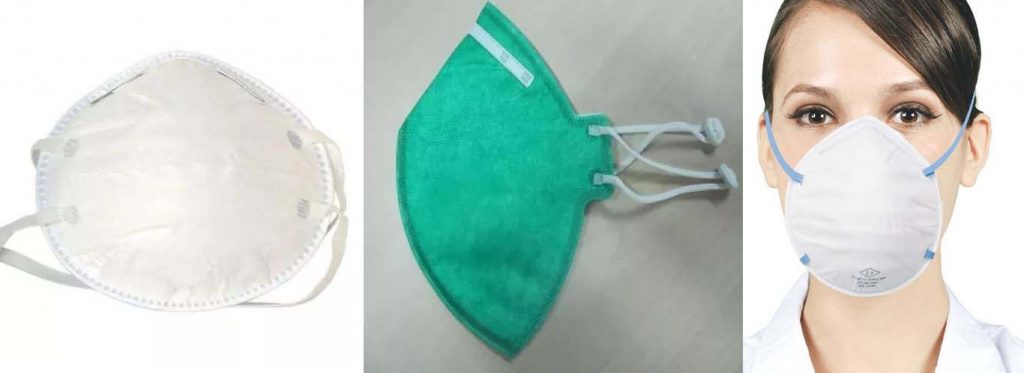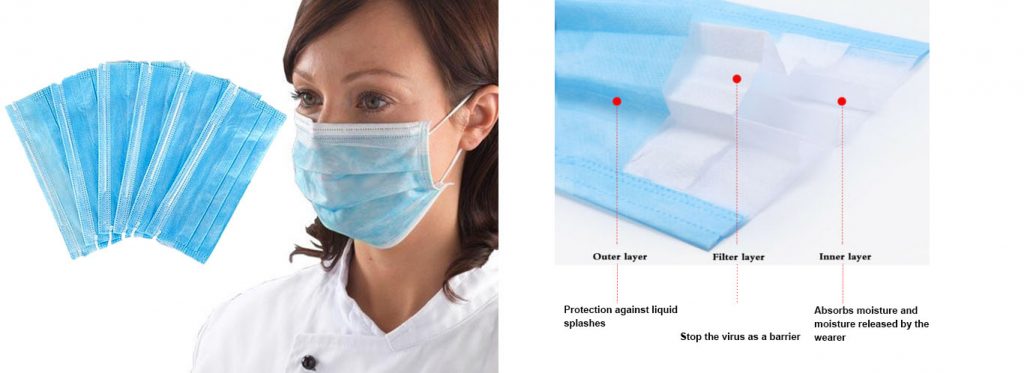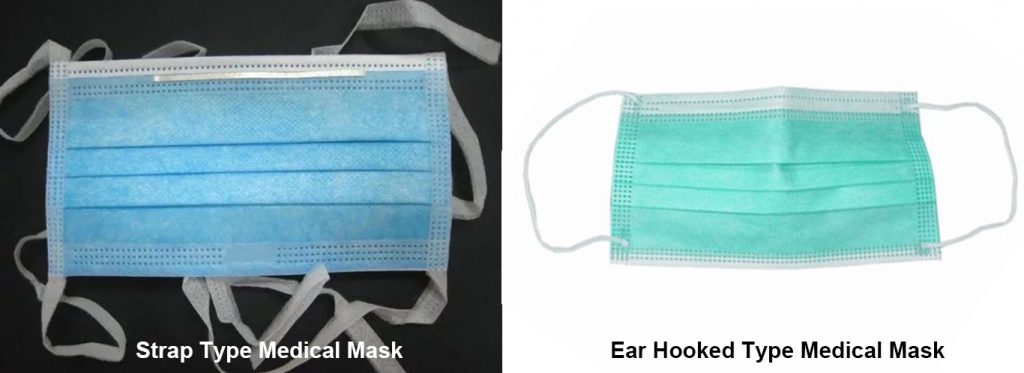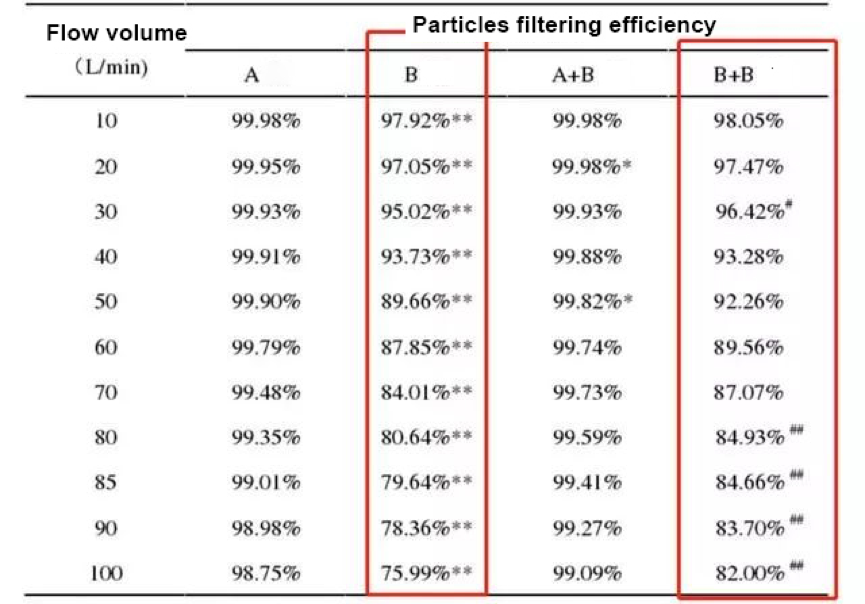Now, mask factories in European and American countries are facing some pressure: on the one…
How to Select the Right Medical Masks to Protect You and Your Family from the Virus – The Ultimate Guide
Masks play a vital role in preventing the spread of the virus. In this article, we will discuss the classification of masks and some very important information based on the standards of certain countries, such as China, the United States, and Europe, and try to break some Rumors about masks and Q&As about face masks.
Please bear in mind: Only those that meet the certain pharmaceutical industry standard(Here in China the standard is YY0469-2011) can be called “medical surgical masks”.
Let’s dive into the types of medical masks first.
According to the literature of the Beijing Medical Device Inspection Institute’s materials, currently China’s medical masks are mainly divided into three types:
- Medical protective mask with the highest protection level;
- Medical surgical masks commonly used in invasive operating environments such as operating rooms;
- Ordinary grade disposable medical masks
Firstly, medical protective masks
What does a medical mask look like?
Equivalent to cup-shaped mask. Common arches and butterflies are shown in the figure below.

Compared with long medical surgical masks and ordinary medical masks, medical protective masks have a good fit with the wearer’s face, can filter particles in the air, and block pollutants such as droplets, blood, body fluids and secretions The filtration efficiency of non-oily particles can reach 95%.
Medical Surgical Masks
Medical surgical masks, which implement the standard YY0469-2011(China’s Standard of Medical Surgical Masks), are commonly used medical masks in operating rooms and other environments where there is a risk of bodily fluids and blood splashes. They can block blood and bodily fluids from passing through the masks and contaminate the wearer. At the same time, the filtration efficiency of bacteria is over 95% However, the filtration efficiency of particles is limited, and most of them have a rectangular design, and the adhesion to the face is not as tight as that of a medical protective mask.

Common medical surgical masks include strap type and ear hook type.

Third, ordinary medical masks
Ordinary medical masks have many names (medical care and disposable medical belong to this category). Medical masks without the words “protection” and “surgical” are ordinary medical masks. It is not required to have a barrier effect on blood, and there is no requirement for tightness, so it is only used for wearing in a general medical environment.
The common ordinary medical masks are mostly ear-hung, and their appearance is similar to that of ear-hung surgical masks, as shown below.

Q&A
Q1: What is N95 and what does it have to do with medical protective masks?
Answer 1: The N95 mask is one of nine anti-particulate masks certified by NIOSH (National Institute of Occupational Safety and Health). Particulate matter protective masks, commonly known as dust masks, are a kind of special labor protection products. Domestic production of particulate matter protective masks requires an industrial product production license, and the products should meet the mandatory national standard GB2626-2006.
“N” means oil-resistant particles (not resistant to oil, the oil fume produced by cooking is oily particles, and the droplets produced by people speaking or coughing are not oily); “95” refers to the NIOSH standard Under the detection conditions, the filtration efficiency reached 95%.
N95 is not a specific product name. As long as the product meets the N95 standard and passes the NIOSH review, it can be called a “N95 mask”.
| Filter Materials Classification | Filtering Efficiency 95% | Filtering Efficiency 99% | Filtering Efficiency 99.97% |
| N | N95 | N99 | N100 |
| R | R95 | R99 | R100 |
| P | P95 | P99 | P100 |
Respirators are rated “N,” if they are Not resistant to oil, “R” if somewhat Resistant to oil, and “P” if strongly resistant (oil Proof)
Package Identification Requirements: In addition to the product model and trademark, the words “NIOSH”, the filtering efficiency level, and the NIOSH certification number of the product are also marked. This number can be queried on the NIOSH official website for users to verify information, such as: NIOSH N95 TC-84A-0007.

Please be noted that those produced in China that meet the corresponding Chinese standard GB2626-2006 are called KN95.
| Filter Materials Classification | Filtering Efficiency 90% | Filtering Efficiency 95% | Filtering Efficiency 99.97% |
| KN | KN90 | KN95 | KN100 |
| KP | KP90 | KP95 | KP100 |
KN: Suitable for preventing non-oily particles, such as various types of dust, smoke, KP: Suitable for preventing non-oily particles and oily particles. Typical oily particles such as soot, oil mist, asphalt smoke, diesel particulates and coke oven smoke.
Package Identification Requirements: In addition to the product model and trademark, the filtering efficiency level, and the certification number of the product are also marked, such as: GB2626-2006 KN95
For masks that comply with the European standard EN149-2001, they are called FFP masks. FFP masks are suitable for both non-oily and non-oily particles, but they are also classified into three different levels according to different filtering efficiency, as shown in the figure:
| Filter Materials Classification | FFP1* | FFP2* | FFP3* |
| Filtering Efficiency | 80% | 94% | 99% |
*Note: Suitable for both oil particles and non-oily particles
Package Identification Requirements: In addition to the product model and trademark, the filtering efficiency level, and the certification number of the product are also marked, such as: EN149-2001 FFP3 CE0121.

The N95 mask has a filtration efficiency of more than 95% for particles with an aerodynamic diameter ≥ 0.3µm. The aerodynamic diameter of air bacteria and fungal spores mainly varies between 0.7-10µm, and it is also within the protective range of N95 masks. Therefore, N95 masks can be used for respiratory protection of certain particulates, such as dust generated during grinding, cleaning and processing of minerals, flour and certain other materials. It is also suitable for liquid or non-oily non-production caused by spraying. Hazardous volatile gas particles. Can effectively filter and purify the inhaled abnormal odors (except toxic gases), help reduce the exposure level of certain inhalable microbial particulates (such as mold, anthrax, tuberculosis, etc.), but cannot eliminate contact infection, illness or death risks of.
The US Department of Labor has recommended that medical personnel use N95 masks to prevent microbial airborne diseases such as influenza and tuberculosis. Take coronavirus as an example (2019-nCoV is a kind of coronavirus), with an average diameter of about 100nm, that is, 0.1.um, plus a propagation vector, such as droplets of about 1-5um in diameter, and N95 filters 0.3um non-oily particles With an effect of ≥95%, N95 can achieve effective filtration.
If it is a hospital-specific N95 mask, it is the aforementioned medical protective mask, that is, the material of the outer surface of the mask has the ability to block pressure body fluid from splashing and penetrating. While meeting the NIOSH requirements, it must also meet GB19083-2010 Medical requirements.
Question 2: What is GB19083-2010 for medical protective masks and YY0469-2011 for medical surgical masks?
A2: The picture below is the standard comparison of three masks.
| Medical Mask | YY/T 0969-2013 | YY 0469-2011 | GB 19083-2010 |
| Name | One-time-use medical face mask | Surgical Mask | Protective face mask for medical use |
| Application | Suitable for covering the mouth, nose and jaw of the user, and is a disposable mask for wearing in ordinary medical environment, and blocking the pollutants exhaled or sprayed out of the mouth and nose. | Disposable masks suitable for use by clinical medical personnel during invasive procedures. It is used to cover the user’s mouth, nose, and jaw, and provides a physical barrier to prevent direct penetration of pathogenic microorganisms, body fluids, particulate matter, etc. | Self-priming filtering medical protective mask suitable for filtering particulates in air, blocking droplets, blood, body fluids, secretions, etc. in medical working environments… |
| Subjects for testing the filtering efficiency | Bacterial aerosol MPS: 3um |
Bacterial aerosol MPS: 3um |
NaCl aerosol CMD: 0.075um MMAD: 0.24um |
| Bacterial filtering efficiency | ≥ 95% | ≥ 95% | Not available |
| Particles filtering efficiency | Not available | ≥ 30% (Non-oily particles) |
Level 1: ≥ 95% Level 2: ≥ 99% Level 3: ≥ 99.97% (Non-oily particles) |
| Ventilation resistance | ≤ 49 Pa (Gas flow: 8L/min) |
≤ 49 Pa (Gas flow: 8L/min) |
≤ 343.2 Pa (Gas flow: 85L/min) |
| Synthetic blood penetration | Not available | 2ml of synthetic blood is sprayed on the outer side of the mask at a pressure of 16.0kpa (120 mmHg). The inner side of the mask should not penetrate. | 2ml of synthetic blood is sprayed on the outer side of the mask at a pressure of 10.07kpa (80 mmHg). The inner side of the mask should not penetrate. |
The outer packaging of the product is printed with YY0469-2011 standard, which can be confirmed as a medical surgical mask.
Someone said online that the spelling of the name of the mask’s outer packaging completely conforms to the six words “medical surgical masks” is also a way to determine whether it is a medical surgical mask. Is it true?
Not exactly! In fact, because of different manufacturers and different product batches, these six words may not all be there.
Question 3: There are many N95 masks with valves on the Internet.
A3: Ms. Wang, a professor of immunology at the School of Basic Medical Sciences, Peking University, said in an interview that a mask with a vent valve is not recommended for the prevention of coronavirus because it may cause the virus to locally accumulate.
Question 4: Is the thicker mask better?
Answer 4: The filter performance of the mask is mainly determined by the filter material in the middle layer. The commonly used filter material is a meltblown non-woven fabric made of polypropylene ultrafine fibers. It is thin, breathable, and can filter efficiently. Particulate matter in the air. The filter material is not as thick as possible. The performance of meltblown non-woven fabrics produced by different manufacturers varies greatly. The specific performance needs to be measured by professional equipment. Masks can only have good filtration efficiency if they contain this kind of filter material. If only ordinary needle-punched nonwovens and spunlace nonwovens are not available, and no melt-blown nonwovens are used, good filtering effects cannot be achieved. This is why the three masks sold on the street are not filtering well enough.
Question 5: Do I have to buy a mask with the highest level of protection?
A5: When wearing a medical mask, you should choose the appropriate level and type according to the type of transmission of the pollutant and the risk. Although the medical protective mask with high protection level has better protection effect, because of the high filter material level, good adhesion and higher breathing resistance, long-term wearing will increase the burden of breathing, causing difficulty in breathing and other discomforts. At the same time, breathability and Hygroscopicity is also worse, which means worse comfort.
Medical surgical masks and medical protective masks can block the pollution caused by blood and body fluid splashes, but if you really need to block the pollution of airborne particles and pathogenic microorganisms, please choose to wear medical protective masks.
Sort according to protection level from high to low: N95 (Medical Protective Masks) > Medical Surgical Masks > General Medical Masks > Other various three non-masks > None
Question 6: One mask is not enough. I wear 2 or more masks. Does it work better?
A6: Some researchers in Huazhong University of Science and Technology have done relevant research, using a single disposable medical mask and a double-layer disposable medical mask as a stack, comparing the filtration efficiency of the particulate matter under different flow rates.
The results show that there is almost no difference in the particle filtration efficiency between the two groups at a lower extraction flow rate (10-70 L / min). At a higher extraction flow rate (80-100 L / min), the filtration efficiency of the double-layer mask Significantly higher than single-layer masks.

Particulate matter filtration efficiency of different types of masks at different extraction flow rates
Note: The data in the table are median filtration efficiency; A: N95 mask; B: disposable medical mask; A + B: N95 mask superimposed disposable medical mask; B + B: double-layer disposable medical mask.
However, in actual wear, it is unlikely to have a flow rate of 80-100 L per minute! With multi-layer masks, not only the protective effect is not enhanced, but the wearing comfort is weakened.
Q7: How often is the N95 mask should be replaced or changed?
A7: The protective effect of any type of mask is time-consuming and must be replaced regularly. It is currently in a special period. In many popular videos of wearing masks, it is reminded repeatedly that masks must not be reused. It is recommended to replace the masks every 2 to 4 hours. If the mask is contaminated, it should be replaced immediately.
The sections of gray typeface below are the definitions of the frequency of changing masks in ordinary times.
At present, there is no clear conclusion on the optimal wearing time of N95 masks by foreign countries including WHO, and there is no relevant regulation on the use time of masks in China.
The National Institute for Occupational Safety and Health (NIOSH) requires the replacement of medical protective masks in the following situations: ① When contaminated with blood, body fluids and other infectious agents of patients. ② When the mask is damaged. ③ When significant respiratory resistance increases. ④ The heavily polluted working environment will result in a relatively high filtration load. Therefore, the use time of N-series masks can only be extended to 8 hours, including continuous or intermittent use.
However, the current domestic GB19083-2010 “Technical Requirements for Medical Protective Masks” does not make requirements on whether medical protective masks can be reused and wearing time. WS / T311-2009 “Hospital Isolation Technical Specifications” proposes “The effectiveness of medical protective masks Continue to apply for 6 to 8 hours. In case of pollution or humidity, it should be replaced in time. “
Research conducted by Beijing Municipal Tuberculosis and Thoracic Tumor Research Center Du Jian and others showed that the filtering efficiency of medical protective masks gradually decreased with the use of time. On the third day, the average filtering efficiency was 94.7%; after 5 working days, filtering The efficiency is reduced to 92.0%; the filtration efficiency is still above 80.0% (80.6%) after 14 working days, so it is pointed out that the medical protective mask can still meet the design requirements when worn for 3 days, and based on cost-benefit considerations, the study proposed that Replacement frequency of 2 medical masks in 5 working days.
Q8: Can I wear a mask all the time?
A8: When wearing N95 masks, the time cannot exceed 4 hours at a time. If you use N95 masks for a long time, it will cause lung damage and may cause emphysema and other problems.
Q9: How to process the abandoned masks?
A9: It is best to prepare a plastic bag for unused masks. Bare masks that contact clothing or other things will increase the risk of transmission.
When removing the mask, try not to touch the outside of the mask. Remember to wash your hands immediately after removing the mask. Try not to reuse disposable medical masks. Once the mask is broken or dirty, it needs to be replaced with a new one immediately.
Currently expanding the production of masks and the continued demand for masks can make the number of masks circulating in the market reach hundreds of millions. The use of a large number of masks also means that in the future, a large number of masks will be discarded or disposed of after use. So how should these disposable masks be used after being worn and can no longer be used to avoid new infections?
“In the hospital, these masks will be put into a clean, airtight bag and thrown into a yellow trash can.” Tao Xiaoqing, director of the Department of Interventional Vascular Medicine at Weihai Haida Hospital, said that medical waste is generally divided into black, yellow and red… Among them, black plastic bags contain domestic waste, yellow plastic bags contain medical waste (including infectious waste), and red plastic contains radioactive waste and other special medical waste.

The relevant person in charge of the Chinese Preventive Medicine Association said that masks are medical waste, according to the “Category of Medical Waste Classification” cotton balls, cotton swabs, drainage slivers, gauze, and other dressings; disposable sanitary products, disposable medical supplies, and Disposable medical devices are infectious waste.
And more masks are used outside the hospital to prevent and avoid infection. These masks are not necessarily infected with the virus. What should I do?
Du Huanzheng, a professor at the School of Environment and Sustainable Development of Tongji University, said in an exclusive interview with the reporter of Science and Technology Daily that wearing masks is to prevent virus infection. Masks that have not been exposed to the new coronavirus are treated as general solid waste and domestic waste. However, judging from the current situation, ordinary citizens can’t judge whether they have been exposed to the new coronavirus when they go out. In accordance with the principle of caution, from the perspective of maximizing the protection of the life and health of the public, it is recommended to put used masks in sealed bags such as plastic bags. In cities such as Shanghai where garbage classification is implemented, put sealed bags in “harmful garbage” bins.
What if some cities do not have stricter rules for garbage separation and disposal? Tao Xiaoqing suggested that the mask waste at home should be placed in a bag to avoid secondary pollution. High temperature and medical 75% alcohol can kill the new coronavirus. It is recommended to use alcohol spray to sterilize the bag and seal it before discarding it.
As for how long the masks infected with the virus will still be able to infect, related virus experts said that the new coronavirus is RNA virus, and the survival time of RNA virus detached from cells in the air is currently uncertain, ranging from hours to days. If you want to buy a reliable mask to antiviral, click at www.testextextile.com/sale/anti-virus-masks. As for masks, if you don’t understand anything else, you can leave a message below.
This Post Has 7 Comments
Leave a Reply
You must be logged in to post a comment.









i am looking for the n95 mak in blue color & i would like to order the minimum amount you can sell me
Thank you for your message, could you please leave your country, then we’ll quote you better asap!Best regards.
Are mask KN95 with GB2626-2006 standard considerer as medical device for protection against coronavirus in China? Is this mask approved for Ministry of Health? Which are the difference between surgical mask (3ply) versus non medical mask (3ply) are this last one considerer medical device in China?.
Thank you
Thank you for your message, could you please leave your country, then we’ll contact you asap!Best regards.
Im from Ecuador
The package of the chinese mask shows outside just GB 19083-2010 without the Package Identification Requirements as indicated above in this report.
“Package Identification Requirements: In addition to the product model and trademark, the filtering efficiency level, and the certification number of the product are also marked, such as: GB2626-2006 KN95”
Is this mask adequate to protect against coronavirus. Should I trust this product despite no product information is available from seller?
is it indispensable both requirements on the package GB2626-2006 KN95 and GB 19083-2010?
thak you for your answer
with regards
Paula L.
Hi Paula, Thank you for your comments, GB 19083-2010, is Medical Protective Mask, can be used for medical staff, sure it can protect against coronavirus, better than GB2626-2006 KN95.
While for the GB2626-2006, since this standard has different levels, KN95 is just one of them, KN90, KN100.
Make it simple, GB 19083 has only one level, so no type marked following the standard.